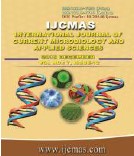


 National Academy of Agricultural Sciences (NAAS)
National Academy of Agricultural Sciences (NAAS)

|
PRINT ISSN : 2319-7692
Online ISSN : 2319-7706 Issues : 12 per year Publisher : Excellent Publishers Email : editorijcmas@gmail.com / submit@ijcmas.com Editor-in-chief: Dr.M.Prakash Index Copernicus ICV 2018: 95.39 NAAS RATING 2020: 5.38 |
In vivo experiment was conducted by utilizing Neoseiulus longispinosus, a promising and potential predator of the spider mite, Tetranychus urticae. N. longispinosus is subjected to the insecticides (monocrotophos and dicofol) selection pressure to ingrain resistance development. It was seen that the realized heritability (h2) for the monocrotophos resistant population was 0.09 and 0.16 for generations F0 to F5 and F10 to F20 generations, respectively and realized heritability (h2) for dicofol resistant population was 0.01 and 0.04 for the F0 to F5 and F10 to F20 generations, respectively. It was analysed that the h2 value estimated at the end of six generations for monocrotophos selected population (F0 to F5) was 1.8 times less than that of F10 to F20 generations and it was four times less for dicofol resistant population at the end of six generations when compared to F10 to F20 generations. This indicates that a high level of resistance to monocrotophos and dicofol can only be realized after long periods of selections (10 generations) in the laboratory reared populations of phytoseiid mite, Neoseiulus longispinosus. The degree of dominance was estimated and it was found that the monocrotophos resistant strain of N. longispinosus had -0.52, -0.58, -0.96, -0.98, and -0.97 for 5th, 10th, 20th, 30th and 40th generations and the degree of dominance for dicofol resistant strain was -1 for all the generations. This indicated that the degree of dominance of insecticide resistance is completely recessive.
 |
 |
 |
 |
 |